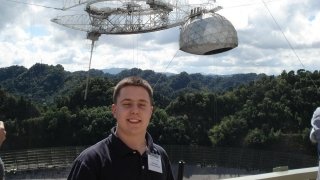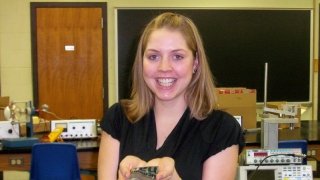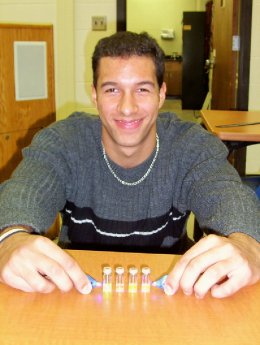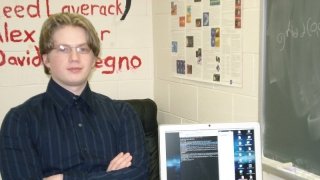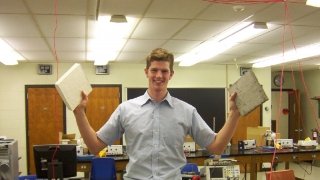Senior Research Projects 2007 - 2008
Seniors present to the physics department the results of their Phys 489/490: SYE Advanced Laboratory and Phys 499: Honors SYE research projects at the end of each semester. The abstracts for their research are below and photos of the student presenters follow afterwards:
The Arecibo Legacy Fast ALFA Survey: The Hunt for Radio Galaxies - Shawn Golley '08
The Arecibo Legacy Fast ALFA (ALFALFA) survey is a blind search for extragalactic emissions of neutral hydrogen (H1) covering 7000 square degrees of the southern sky over a redshift range of –1,600 to 18,000 km/s. I continued the study of a swatch of sky between 11h 43m and 11h 53m of right ascension and 12° 0′ and 14° 0′ declination begun by Jamie Lomax ’07. I used the NASA Extragalactic Database and the ALFALFA Consortium Catalog to flesh out the information about the sources of hydrogen found by Lomax. I began the process of looking at some of the particular structural features of this region, including the Hickson Compact Group of galaxies HCG 059. I also examined the process of hyperfine splitting within the hydrogen atom which produces emissions at a wavelength of 21 cm – the wavelength observed by the ALFA array at the Arecibo Telescope. Additionally, I created detailed documentation for using the gridview data analysis software used in the ALFALFA project.
For more information, contact Dr. Aileen O'Donoghue
Using Gamma Spectrometry and Radon Detection to Determine Uranium and Radon Presence in Well Water - Alexandra Kusnezov '08
Water taken from a well in Russell, New York, belonging to Bill Olsen, was determined to contain Uranium and Radon. These elements can cause damage to DNA and possible cancerous growths if ingested through eating or swallowing. The Uranium was detected using a Gamma Spectrometer and the Radon was detected using a Pylon Model AB-5 Radon Detector. Spectra from the Uranium runs were analyzed and compared to gamma energies in the Uranium-238 decay scheme. The spectral peaks were consistent with Uranium-238 gamma energies, and further testing of the Uranium should be performed. The Radon detection confirmed that there is radon activity, but the results were inconsistent and further testing needs to be performed to quantify the amount of activity. I can say that there is possibly Uranium-238 present in the water as well as Radon-222 and ingestion, through eating, swallowing, and inhalation, of the well water should be avoided.
For more information, contact Dr. Karen Johnson
Evaluation of InP QDs as Sensitizers for Solar Cells - Joe Shehata '08
The recently developed dye-sensitized solar cell (DSSC) has attracted much attention due to its potential for high solar conversion efficiency and low manufacturing and maintenance costs. It functions based on the sensitization of mesoscopic oxide films by dyes and has demonstrated potential as a clean, renewable energy source. A variation of this new type of cell incorporates quantum dots (QDs) as a substitute for the conventional dye molecules. The QD-sensitized solar cell has several advantages over the DSSC owing to the many unique properties of the QD, most notably, the tunability of its band gap and its ability for multicarrier excitation. Here, we constructed an indium phosphide QD-sensitized solar cell and characterized it using common photovoltaic measurements in order to evaluate the potential advantages of using QDs as a sensitizing material. The efficiency of the cell was calculated under non-standard conditions and found to be 1.76x10-4 for an intensity of G = 0.401 W/m2 and 7.4x10-5 for an intensity of G = 0.094 W/m2. Fill Factors were also calculated and had values of 0.39 at G = 0.401 W/m2 and 0.25 at G = 0.094 W/m2.
For more information, contact Dr. Catherine Jahncke
Continuing the ALFALFA Survey: Finding Masses of Neutral Hydrogen Sources with HIMassCalc - Tristan Wolfe '08
I have contributed to the ongoing Arecibo Legacy Fast ALFA Survey (ALFALFA). This is a blind survey using the Arecibo Radio Telescope’s L-Band Feed Array (ALFA, a new receiver) seeking clouds of neutral hydrogen (HI) over a 7000 square degree portion of sky. HI is detected with ALFA by its emission of energy at a wavelength of 21 cm in the L-band of radio frequencies at 1420 MHz. I worked with a cube of data from ALFALFA; a 2.4 square degree section of sky centered about 11h48m +13°, in the constellation Leo across a frequency space spanning 1335 to 1435 MHz in 4096 5-MHz channels. The frequencies correspond to a Doppler-shifted velocity range of –1,600 km/s to 18,000 km/s. The negative range includes approaching (blue-shifted) sources such as clouds of HI within our galaxy. Taking the velocities of the receding (red-shifted) sources as due to the expansion of the universe gives a corresponding distance range out to 850 million light years. My project was the construction of a computer programs called HIMassCalc, used to calculate the total flux density of these sources, or their rates of energy flow through given areas of space, from graphs of their spectral flux densities (flux density per channel of frequency space). The total flux was given by the area under the curve of the spectral flux graphs, a summation of the spectral flux values multiplied by the number of frequency channels within the appropriate range. The program then calculated the masses from the total flux density. The resulting masses were compared to expected values of HI masses in certain sources, as well as stellar masses given by optical counterparts of some of the sources.
For more information, contact Dr. Aileen O'Donoghue
Assessment of Covering Materials for Mitigation of Radon from Concrete - Kit Wright '08
Abstract: Radioactive radon gas is emitted from concrete and enters indoor environments, causing a health hazard. I assessed the effectiveness of using different covering materials to prevent or reduce radon emission from concrete. Sample concrete slabs were made form Quikrete ready mix concrete and covered with linoleum tile, paint, and plastic sheeting. I measured the decays of radon in an enclosed space containing concrete slabs. In general, the addition of a covering material to a slab reduces the equilibrium level of radon in a closed space by about 50%, compared to uncovered slabs. It appears that an airtight barrier is a simple, yet effective solution. From my results I projected the radioactivity in a typical basement with poured concrete walls. The addition of covering materials to concrete dropped the activity levels to below the United States action level for this common type of room. Covering materials are an effective method for reducing radon levels and meeting national standards for radon in the indoor environment.
For more information, contact Dr. Karen Johnson

